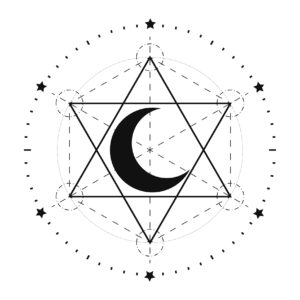
The pentagram predates Christianity by as much as 6,000 years, but it’s been defined and interpreted by Christians and non-Christians alike throughout the ages. While it’s been associated in modern times with Wicca and various forms of Paganism, some have perceived it as an artifact of devil worship. However, the pentagram has taken on many meanings in a wide variety of cultures and contexts. A peek at the fascinating history behind this oft-maligned symbol should help you understand its nature.
Origins in the Ancient World
During the sixth millennium B.C.E., humans in the Middle East were beginning to use copper. Apparently, they were also drawing pentagrams, according to the New World Encyclopedia. The oldest documented instance comes from the Tigris-Euphrates region in present-day Iraq. Pentagrams have also been found in Israel, estimated to date from around 4,000 B.C.E. Scholars have speculated that they could have signified the five planets commonly visible in the night sky, or the “vault of heaven.” Nevertheless, these guesses cannot be confirmed due to the lack of written records from this time period.
Meanwhile, there is some evidence that the pentagram existed in ancient Greece. Religious Tolerance, a multi-faith group dedicated to documenting information on human belief systems, conjectures that members of the Pythagorean school of knowledge used it as a clandestine mark to help identify each other and as a sign of “mathematical perfection.” Meanwhile, some theorize that it may have existed in ancient Celtic religions to represent the Morrigan, a goddess of war, destiny and death.
Mixed Legacy in the Christian World
After the advent of Christianity, the pentagram came to take on even more meanings and connotations. Some referred to it as the “five wounds of Christ,” a representation of the injuries that Jesus is said to have suffered while hanging on the cross. In Arthurian legends, Sir Gawain emblazoned it on his shield to signify “five knightly virtues” of generosity, courtesy, chastity, chivalry and piety. Some tarot decks contain a suit of pentacles in place of discs and associate it with the earth element.
Unfortunately, the history of the pentagram appears somewhat unclear from the Middle Ages up until modern times. The Symbol Dictionary’s entry states that pentagrams were used during medieval times as protective charms against witches and demons. Even so, Religious Tolerance’s entry claims that they began to take on evil connotations thanks to witch trials and the persecution of accused innocents. What further muddles matters is its adoption by Church of Satan founder Anton LaVey for incorporation into the Sigil of Baphomet, a combination of an inverted pentagram laid over a goat’s head.
Use in Wicca and Witchcraft
Modern witchcraft practitioners and Wiccans have employed the pentagram in their magical and ritual practices. Typically, it symbolizes five elements: earth, fire, air, water and spirit. When a circle is drawn around the star to connect its outer points, this can allude to bringing air, earth, fire and water into harmony with each other. Opinions differ as to whether the pentagram should be shown with a single star point aimed upward, or in the inverted rendering as it appears in the Sigil of Baphomet. While some Wiccans insist on displaying it upright to distinguish themselves from Satanists, other Pagans use both upright or inverted versions.
Throughout history, various people and cultures have assigned different meanings to the pentagram. While some individuals see it as a controversial or evil sign, others consider it a sacred symbol. Whether it’s a high regard for the roles mathematics and geometry play in the structure of the universe, protection against harmful entities or in a ritualistic context to denote the elements, the pentagram is proof of how human beings create and ascribe meanings to objects in our world.

